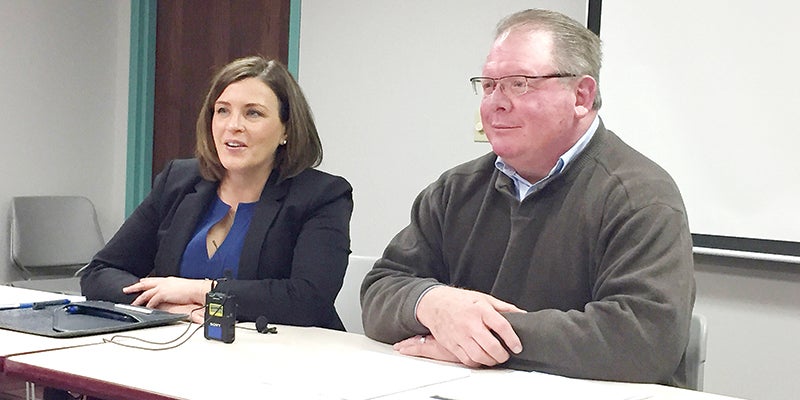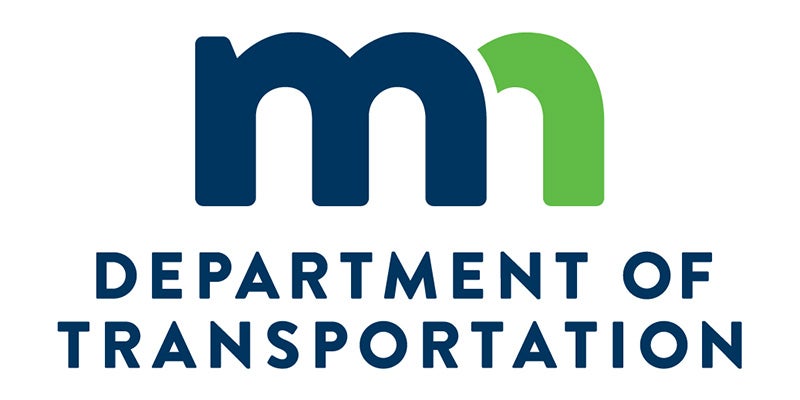GOP health plan could hit Mower, SE Minn. hard
Published 7:01 am Sunday, March 12, 2017

- MNsure CEO Allison O’Toole and AdvisorNet Financial’s Chuck Moline talk in the Town Center Building in downtown Austin on Friday about health care changes. Jason Schoonover/jason.schoonover@austindailyherald.com
“Changes are coming.”
That’ how MNsure CEO Allison O’Toole succinctly summed up the uncertainty surrounding Minnesota’s health exchange and the Affordable Care Act during a visit to Austin Friday.
While O’Toole promised MNsure would open for its fifth enrollment period on Nov. 1, she and AdvisorNet Financial’s Chuck Moline admitted the future beyond that is harder to predict.
“The future is really kind of the elephant in the room,” said Moline, a MNsure broker.
Nationally, the Republican party continues work to replace the Affordable Care Act, commonly called Obamacare, with the American Health Care Act.
MNsure leaders say more than 420,000 people in the state could be affected by the Republican-backed bill: 120,000 are at risk of losing private health insurance through MNsure and 300,000 are at risk of losing Medical Assistance and MinnesotaCare.
“A lot of people in this area are going to be negatively impacted in terms of what they’re paying,” O’Toole said.
GOP bill could hit southern Minnesota hard
O’Toole warned residents in Mower County and southeast Minnesota could be hit hard.
“People in southern Minnesota, particularly southeastern Minnesota, are going to be hit hard under this new plan,” O’Toole said.
O’Toole directed people to the Kaiser Family Foundation website, where the nonpartisan health group created a graphic that shows how people will be affected by the law change based on their age and income.
That site, which shows age and salary groups in Minnesota seeing reductions in the number of tax credits they’re eligible for.
A 40-year-old making $30,000 a year would see a 44 to 45 percent increase in what they pay in health insurance under the plan.
“That is serious,” O’Toole said. “That is real money for these families.”
The bill will likely be much different after the ensuing votes and debate, but Moline said it’s currently looking like it could mean a lot more out-of-pocket-money for consumers.
Moline says he’s read and seen that increases in southeast Minnesota could range from 25 to 50 percent.
While Moline said the new proposal would not eliminate exchanges like MNsure, O’Toole noted some state proposals send the state program to the federal exchange, where she said there is much confusion right now on the federal level.
O’Toole and Moline both admitted to concerns about how quickly the Republican bill is moving.
“The quicker it goes through, the less time Minnesotans have to understand the changes coming.”
Current coverage
MNsure is the online tool for Minnesotans who don’t get their coverage through their employers. Lower income Minnesotans can access MinnesotaCare and Medical Assistance, and higher income residents can access private insurance as well.
MNsure does not, however, set premiums, deductibles or doctor networks, which come from insurers. Likewise, the federal government sets mandates, penalties and deadlines.
O’Toole compared MNsure is to health care as Kayak or Orbitz is to flying — they don’t set the rates, but they help find the best options.
MNsure is the only place where Minnesotans can access tax credits to offset the costs of their premiums, which have risen sharply.
On average, tax credits offset about $7,500 a year across the state and are higher in southeast Minnesota, offsetting close to $1,000 a month for about $11,800 a year, according to O’Toole.
“That is huge money that is making a difference for your residents here,” O’Toole said.
MNsure offers in-person assistance to anyone who needs through brokers like Moline and other providers in the state.
“For thousands of Minnesotans, they couldn’t afford to protect themselves without those tax credits,” she said.
MNsure enrolled about 121,000 Minnesotans in private coverage this year, which is up 40 percent from last year and 96 percent up from the first year.
Overall, 1.2 million Minnesotans are enrolled in state-sponsored healthcare programs.
MNsure also saw increases in the public plans too, which O’Toole called a positive sign showing that MNsure is getting more Minnesotans enrolled during a time when a dark cloud has been hanging over them after Blue Cross dropped out, premiums increases and much political uncertainty.
“Make no mistake, this last open enrollment period was no walk in the park, but despite all that we had a record-breaking year,” O’Toole said.
MNsure is always under a lot of scrutiny, but O’Toole welcomed it as the strive to be transparent.
Seeking a solution
While Moline admits MNsure has had rocky moments and technical struggles early on, he said there’s been improvements every year in the program.
AdvisorNet Financial has been a MNsure partner since the beginning, covering from Albert Lea to the Mississippi River.
Coming off the fourth open enrollment periods Moline says this year went well with the system; however, certain individuals who didn’t qualify for tax credits and insurers saw hefty premium hikes.
Moline praised state Sen. Dan Sparks and Rep. Jeanne Poppe, both DFL-Austin, for helping to free up money to help people with high premiums.
With the Republican-led American Health Care Act being discussed in Congress, Moline said people are wondering whether things will get better.
Moline argued Congress isn’t moving ahead in a way that addresses many of the vital insurance issues driving concerns and challenges.
Insurance, Moline noted, involves underwriting risk and trying to keep the bad risk out so the pool of insured people is as healthy as possible. Then insurers can charge as low a rate as possible.
However, people deemed uninsurable or with preexisting conditions has been in part behind hikes, Moline noted. He argued the focus needs to return to reinsurance programs to address such people.
That keeps the pool of insured as clean as possible to keep rates low and competitive.
Since premium increases were going up well before the Affordable Care Act because of higher cost of care, Moline said they need to involve groups like Mayo, Mayo Health Systems, Allina and other major health providers in the conversation.
“They’ve got to be part of this overall solution if we’re going to make this thing work,” he said.
That comes at a time when the market has not been stabilized yet.
The risk is driving costs, so Moline promoted a reinsurance program like the past Minnesota Comprehensive that guaranteed coverage to people with preexisting conditions.
The Minnesota Legislature is discussing a re-enrollment program, which O’Toole called good news. She praised the state legislature for being focused on market stabilization.





